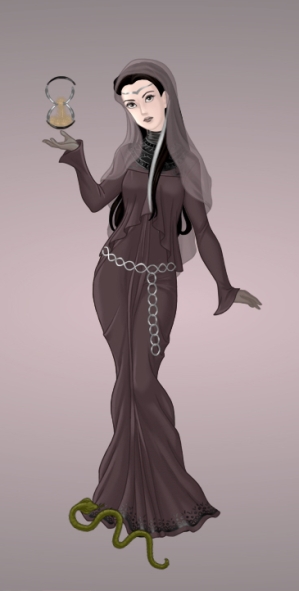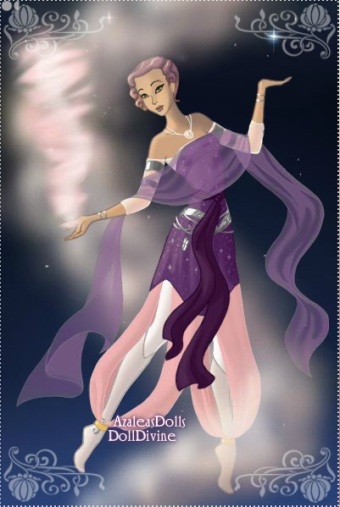Saturn is a difficult planet. She is the Greater Malefic, and her associations are the banes of human existence. Hardships, difficulties, blockages, the passage of time, old age, and death are all in her domain. Yet, these are all essential for manifestation. Saturn is necessary for our existence.
The Janya of Saturn: Sai Rhavë
 The Janya or Great Angel that governs Saturn in Filianism is Sai Rhavë. Sai Rhavë is one of the three Janyati associated with the Feminine Trinity. Sai Raya is associated with the Mother, Sai Candre is associated with the Daughter, and Sai Rhavë is associated with the Dark Mother.
The Janya or Great Angel that governs Saturn in Filianism is Sai Rhavë. Sai Rhavë is one of the three Janyati associated with the Feminine Trinity. Sai Raya is associated with the Mother, Sai Candre is associated with the Daughter, and Sai Rhavë is associated with the Dark Mother.
One of the big debates in monotheistic religions is whether God is imminent and with us in our daily lives, whether God is a Creator who is apart from Creation, or whether God is so far beyond us to be incomprehensible to us. In Filianism, this is not a debate, but all three are true. In order to help us understand this, we use the model of the Feminine Trinity. I say, model, because the full Truth is beyond our capability. For this reason, in a sense, all religious doctrines are models. Just as we cannot truly see the Solar System but use models and pictures to understand it, in the same way, we need models and pictures to comprehend the Divine.
In the Trinity, the Mother is our Creatrix. She made us and loves us unconditionally. Yet, we became separated from her. In the Filianic tradition, like the physical Sun, She is “too bright for us to look upon.” Because of this, She gave birth to the Daughter. The Daughter is the aspect of Dea that is with us and cares about our earthly needs. When we experience the presence of Dea, it is always in one of the forms of the Daughter.
The Dark Mother is the aspect of Dea that is completely beyond our comprehension. While the Mother is too bright for us to look upon, the Dark Mother is beyond our perception altogether. She is the holder of the Mysteries that we cannot understand from an unEnlightened state, such as why suffering and evil exist or how Evil and Good are both necessary parts of manifestation. In the Filianic Tradition, she is “the Darkness beyond the Light and the Light beyond the Darkness.”
Of Her, not much can be said, but this passage from The Gospel of Our Mother God may help a little.
She that hath no beginning nor any end; She that did stand in the heart of chaos and make all things harmonious, She that doth bear the worlds within Her hand; the maid that knoweth Her is truly free.
She that is the maker of being and of unbeing; She that is all that is and all that is not; the maid that knoweth her in truth hath left all worlds; hath left in truth the body and the mind.
The Clew of the Horse, 45-46, Authorised Version
For obvious reasons, there can be no images of the Dark Mother. On the other hand, even though She is associated with the Dark Mother, Sai Rhavë is also one of the Seven Great Angels, and there are some feminine images for her. These include Kali from the Vedic Tradition and all “dark” and “crone” forms of goddesses. Filianism does not recommend direct devotion to the Dark Mother or to Sai Rhavë.
Saturn Returns
The Saturn or Rhavic principle is a paradox. On one hand, it is beyond manifestation, and its highest level is no less than Enlightenment itself. On the other hand, it is deeply wound up with the material world and what binds us to it. One of the ways that the Rhavic principle/Saturn binds us to materiality is through time. Saturn is the great timekeeper of our lives.
The Saturn cycle marks all of the natural ages for our rites of passage towards maturity. The first time transiting Saturn squares our natal Saturn is at the age of seven, which is considered the Age of Reason. We have our first Saturn opposition at the age of fourteen, which is the average age of puberty. Our second Saturn square is when we are twenty-one, which is the common age when children are considered full adults.
The first time that Saturn returns to the position it was in when we were born is when we are around 29.5 years old. The age we are during our first Saturn return can vary, however, from age 27 to 30, and because of retrogrades, it can last for a couple of years. This marks the end of the first stage of our lives as we move towards full maturity.
Our second Saturn return happens between 57 and 60, and it is at this stage that we move from “mature adult” to “honored elder.” If we live to age 87-90, we will have a third Saturn return. A very small handful of people may live to their fourth Saturn return, which would be around 117-120 years old, but that is very rare indeed.
For most people, Saturn divides our lives into three parts: childhood, maturity, and old age. Of course, a 25-year-old is not a child and a 62-year-old is not exactly old, but the Saturn boundaries are real. Once they are crossed, we change dramatically.
The Material World and the Soul
Each Janya and her planet have the same glyph. All of the glyphs are made from a combination of three symbols, the Circle of Spirit, the Crescent of Soul, and the Cross of the Material World.
 As in the glyph for Sai Thamë, the Circle of Spirit, or the connection with the Solar, is absent. There is just the Soul, or the connection with the Lunar, and the material world. In Sai Rhavë glyph, however, the material world is sitting on top of the Soul. This seems an apt depiction. Unlike in the glyph for Sai Vikhë in which the cross is off to the side, in this glyph, the cross is directly over the Soul and dominating it.
As in the glyph for Sai Thamë, the Circle of Spirit, or the connection with the Solar, is absent. There is just the Soul, or the connection with the Lunar, and the material world. In Sai Rhavë glyph, however, the material world is sitting on top of the Soul. This seems an apt depiction. Unlike in the glyph for Sai Vikhë in which the cross is off to the side, in this glyph, the cross is directly over the Soul and dominating it.
Astrological Associations of Saturn
Sect: Day
Oriental Element: Tsuchi 土 (Earth)
Rules Aquarius, Day House

Rules Capricorn, Night House

Exalted in Libra
In Detriment in Leo and Cancer
In Fall in Aries
Daytime Triplicity Ruler of Air
Participating Triplicity Ruler of Fire
In Joy in the 12th House
Temperament:
Oriental (in front of the Sun): Cold and Wet
Occidental (behind the Sun): Cold and Dry
Day of the Week: Saturday
Orb: 9° (Moiety 4.5°)
Colors: Indigo, brown, and black
Plants: Hemlock, fern, poppy, moss, mandrake, hemp, willow, and pine
Animals: Cats, dogs, serpents, mice, eels, tortoises, and bats
Metal: Lead
Stones: Sapphire, lapis lazuli, all black stones, and all stones that are unpolishable
The Way of Renunciation
All of the non-Luminary planets have a spiritual path that is associated with them. The spiritual path associated with Saturn is that of renunciation or releasing oneself of all social status and material belongings. This is a hard path. It is the way of the hermit or the spiritual beggar.
